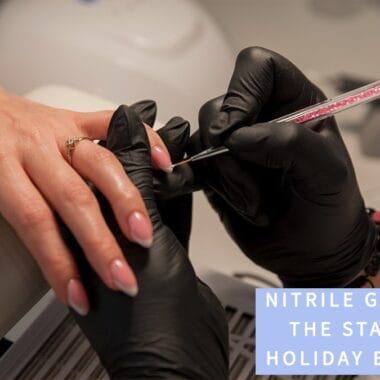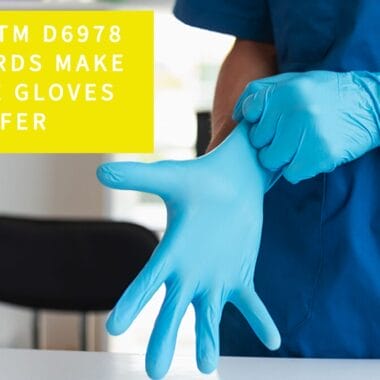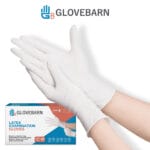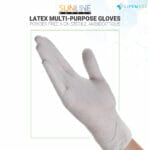When it comes to painting, whether it’s a professional job or a DIY project, choosing the best gloves for painting can impact both the quality of the work and the painter’s safety. Painting gloves are durable and flexible, designed to meet the specific needs for PPE in the painting industry.
The Best Types of Gloves for Painters
In the painting industry, personal protective equipment (PPE) gloves help ensure the safety of the painter and the quality of their work. Suitable painting gloves protect against the harsh chemicals in paints, thinners, and removers. They shield the skin from potential burns, irritation, and long-term skin conditions. In addition to chemical protection, these gloves are a barrier against physical hazards such as cuts from handling tools, opening paint cans, or working with rough surfaces.
Painting gloves typically have enhanced grip and control with textured surfaces or fingertips to handle brushes, rollers, and other painting tools easily. This not only improves the quality of the paint job but also promotes safety by preventing slippage and accidents. The most common gloves painters use in the painting industry are nitrile, latex, vinyl, and neoprene gloves.
Wearing PPE gloves for painting is integral in maintaining cleanliness during the painting process. They prevent the transfer of oils and dirt from the hands to the paint surface, which could also affect paint adhesion and finish. For painters with latex allergies or sensitivities, nitrile gloves offer a safe option without risking protection. Following safety regulations is crucial in the painting industry, and PPE gloves are often required to be worn by professional painters. When choosing painting gloves, the painter must consider the type of paint and chemicals used, the level of skill, and the comfort of the painter’s hands.
The Use of Nitrile Gloves for Painting
The best type of gloves used for painting are nitrile gloves, promoting safety and skill for all levels of painters. Nitrile gloves, made from synthetic rubber, allow painters to function proficiently while having a steady hand while painting. Wearing the correct type of gloves while painting not only ensures the painter’s safety but also promotes the efficiency and quality of the paint job.
Chemical Protection: The Core Benefit
Nitrile gloves are a type of disposable glove that offers chemical protection against paints, solvents, and thinners filled with chemicals that can harm the skin. Nitrile’s chemical-resistant properties surpass those of other glove materials, making it a safer glove for handling hazardous materials in the painting industry. PPE gloves with chemical protection shield the skin from harmful substances that can cause irritation, allergic reactions, or severe health issues.
Durability and Puncture Resistance: Why It Matters
Painters in the painting industry or working on a DIY project often interact with sharp objects and rough surfaces. Nitrile gloves’ puncture resistance guarantees protection for painters from cuts and abrasions. Durable gloves are essential in painting environments, ensuring they remain intact and provide consistent protection. Puncture-resistant gloves reduce the risk of immediate injuries and long-term conditions like contact dermatitis. Nitrile gloves are also more robust and puncture-resistant than latex or vinyl gloves.
A Safe Choice for All: Latex Allergy Considerations
With latex allergies and sensitivities being a joint health and safety concern, nitrile gloves offer a safe alternative. Nitrile gloves are latex-free disposable gloves that reduce the risk of allergic reactions. Wearing latex-free painting gloves like nitrile while painting suits nearly every individual in the painting industry.
Enhancing Precision: Sensitivity and Dexterity in Painting
Nitrile gloves are an excellent balance between protection and tactile sensitivity for painting gloves. Painting gloves with good tactile sensitivity is crucial, where precision and attention to detail are necessary for a high-quality finish. Whether it’s a professional paint job or a personal project, gloves that allow a full range of movement are essential when handling tools and performing detailed tasks.
The Versatility of Nitrile Gloves in Painting Tasks
Nitrile gloves are more than just painting gloves; they can also be used for related tasks like cleaning up and preparation in the painting industry. As a multi-purpose disposable glove, they are a cost-effective investment for painting PPE.
Improved Grip for Safer Handling
Many nitrile gloves are designed with a textured surface to enhance grip. Non-slip grip gloves in the painting industry are beneficial when handling slippery objects like paint cans, brushes, and tools, reducing the risk of accidents. Paint stains on the skin are not only difficult to remove but can also lead to skin issues. Wearing nitrile gloves while painting protects the hands from paint and other staining materials, keeping painters clean and professional.
Protecting Skin Health: Minimizing Irritation and Dermatitis
Regular skin exposure to paint and cleaning products can irritate the skin. Nitrile gloves act as a protective layer while painting, limiting direct contact with substances and lowering the risk of skin conditions like contact dermatitis.
Convenience and Hygiene: The Disposable Advantage
Nitrile gloves are one of the most durable disposable gloves, making them hygienic and convenient for quick changes between painting tasks and wearing disposable gloves. In contrast, painting minimizes the risk of cross-contamination, which is especially important in color-sensitive paint jobs.
Why Nitrile Gloves Are Essential PPE Painting Gloves
Nitrile gloves are a critical component of PPE in the painting industry, promoting safety, efficiency, and quality. Using appropriate personal protective equipment (PPE) in the painting industry is a legal requirement in some jurisdictions. Nitrile gloves meet safety standards, helping painting businesses to remain compliant. The quality of nitrile gloves is centered around their chemical resistance, durability, allergen-free material, and tactile sensitivity. They are an indispensable type of PPE for all painters. Nitrile glove’s versatility and quality remain constant as the painting industry evolves with new techniques and materials.
Painters are required to wear gloves while painting primarily for safety and health purposes. Painting gloves help maintain cleanliness in the industry, keeping painters free from stains and speeding up the cleaning process after the job. In many professional settings, wearing PPE gloves is a regulatory requirement by the Occupational Safety and Health Administration (OSHA) to ensure worker safety. The material of nitrile gloves is best for painting as it provides a superior level of protection with its chemical and puncture resistance. Wearing nitrile gloves in the painting industry is critical for improving safety, efficiency, cleanliness, and compliance with health and safety standards.
References:
- Mayo Clinic, 2023. Contact Dermatitis.
- U.S. Department of Labor. Occupational Safety and Health Administration: Personal Protective Equipment.


















